History
Goa Inquisition : Native Hindus tortured and massacred by Portuguese Christian missionaries
Published
5 years agoon
By
Vedic Tribe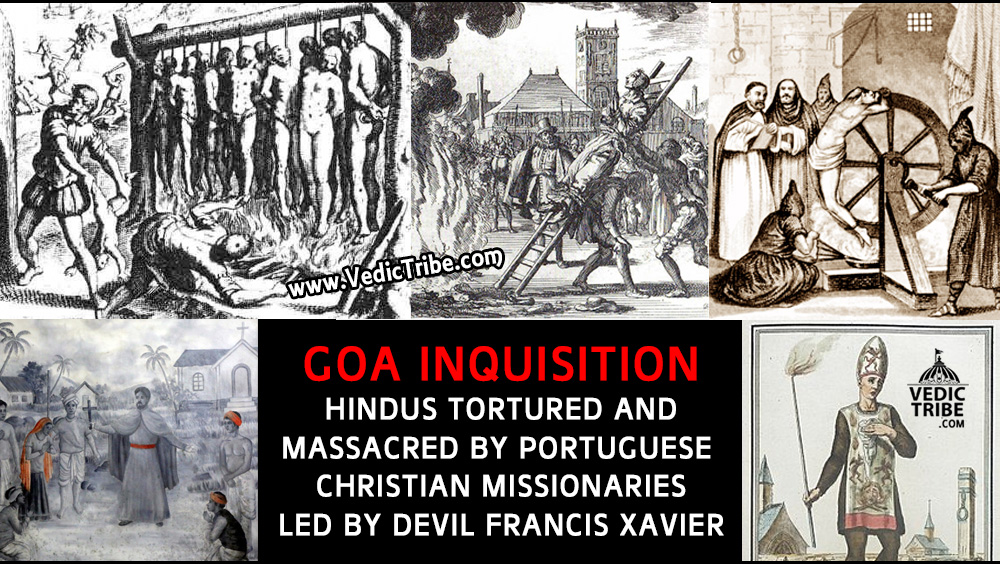
The “‘Goa Inquisition”‘ was the office of the Inquisition acting in the Indian state of Goa and the rest of the Portuguese empire in Asia. Established in 1560, the inquisition was aimed primarily at Hindus with inquisitions against Indian Muslims, Indian Jews, and others.
By the time it was suppressed in 1774, the inquisition had had thousands of people were given the death penalty, tortured and executed.
The French philosopher Voltaire wrote about the Goa Inquisition where he observed:
“Goa is sadly famous for its inquisition, which is contrary to humanity as much as to commerce. The Portuguese monks deluded us into believing that the Indian populace was worshipping the Devil, while it is they who served him”(Voltaire, Lettres sur l’origine des sciences et sur celle des peuples de l’Asie (first published Paris, 1777, letter of 15 December 1775)
Sephardic Jews living in Goa, many of whom had fled the Iberian Peninsula to escape the excesses of the Spanish Inquisition to begin with, were also persecuted.
The records speak of the necessity for hundreds of prison cells to accommodate fresh victims. Seventy-one “autos da fe” were recorded. In the first few years alone, over 4000 people were arrested, with 121 people burnt alive at the stake.
The Hindus of Goa were one of the most affected by the inquisition. The condemned Hindus were publicly burned at the stake in the square outside the Sé Cathedral in batches during ceremonies . Those who confessed to their accused heresy would be strangled prior to the burning. In this case, heresy was to practice a faith other than Christianity.
Historian R.N. Sakshena writes “.. in the name of the religion of peace and love, the tribunal(s) practiced cruelties to the extent that every word of theirs was a sentence of death”.

Thousands of Hindus were tortured and killed for refusing to convert to Christianity.
Anti-Hindu laws and prohibitions
Laws were passed banning Christians from keeping Hindus in their employ, and the public worship of Hindus were deemed unlawful:
A large number of restrictive religious laws were enacted, including the banning of Hindu musical instruments and clothing. Hindu temples were converted or destroyed, and Christian churches built in their place, often from the materials of the temples they replaced. Throughout this period several important Hindu texts were burned in an effort to saturate the area with Christian religious texts.
Orders were issued that Hindu children who were orphaned be “taken immediately and handed over to the College of St. Paul of the society of Jesus of the said city of Goa, for being baptized, educated and indoctrinated by the Fathers of the said College and being directed by them and placed in positions according to their respective aptitudes and abilities”. The order was endorsed by the viceroy of Goa, Antao de Noronha and the Governor, Antonio Moniz Barrette. While the original order applied only to orphans, there were frequent complaints that Hindu children with parents were kidnapped from their families and forcibly baptized. Some Hindu families secretly smuggled their children out of Goa. Other less fortunate Hindus paid extortion money to Christian priests to keep their children from being kidnapped and baptized
Many Christian priests disagreed with these draconian measures and sympathized with the Hindus, generating a brief lull in the forced conversions. However, Francis Xavier, the “Father of the Christians”, upon hearing of this, complained to the Archbishop and reinstated a new wave of forced conversions.
Several [anti-Hindu] laws were enacted with the expressed intent to “humiliate Hindus” and encourage conversions to Christianity. The viceroy ordered that Hindu pandits and physicians be disallowed from entering the capital city on horseback or palaquins, the violation of which entailed a fine. Successive violations resulted in imprisonment, Christian palaquin-bearers were forbidden from carrying Hindus as passengers. Christian agricultural laborers were forbidden to work in the lands owned by Hindus and Hindus forbidden to employ Christian laborers. The inquisition guaranteed “protection” to Hindus who converted to Christianity. Thus, they initiated a new wave of baptisms to Hindus who were intimidated by their brutality into converting.
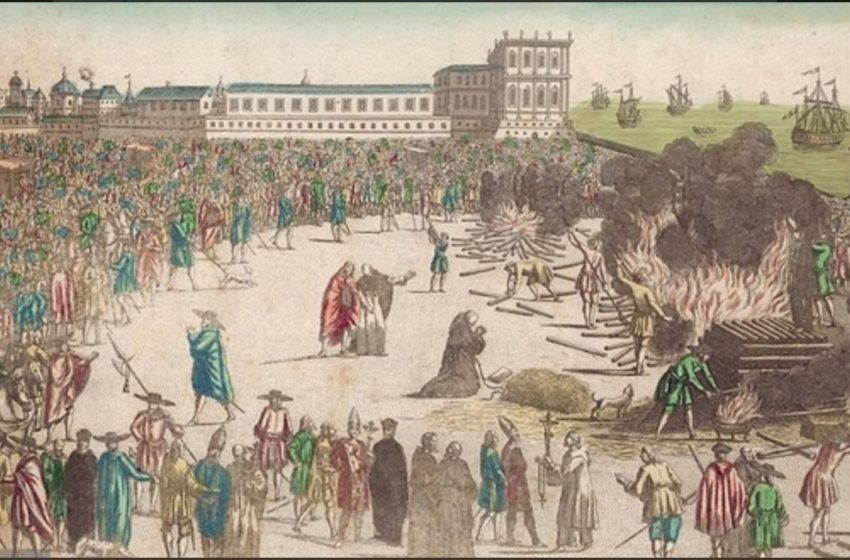
The inquisition supplied the ecclesiastic Jesuit priests with a strong state-sanctioned weapon to use against the Hindu population of the region. Moderate Catholics who tried to build bridges with Hindus were also persecuted. Even the governor of Goa from 1588-1591 was investigated when he consulted Hindu clerics about the auspicious dates concerning the arrival of ships. The adverse effects of the inquisition were tempered somewhat by the fact that Hindus were able to escape Portuguese hegemony by migrating to other parts of the subcontinent.
Hindus who were arrested for repeated violations of the laws were taken in by the inquisition to the “Palace of the Goa Inquisition” for “confessions”. The confessions were attained by various torture techniques. Techniques included Hindus being tied up and having their feet burned slowly with sulphur, water torture techniques and racks on which the victims were manacled and their joints slowly dislocated by stretching. This “strappado” method was a particular favorite among the inquisitors. Thumb-screws and leg-crushers called Spanish boots were also employed. Often, boiling oil was poured on their legs and sulphur dropped on their bodies with lighted candles held beneath their armpits. Another technique involved fixing the victims to revolving tables and whirling them round until they were nauseous. These techniques were applied to the victims until they were weakened to the point of being persuaded to “convert” to Christianity and “confess”.
Those who “confessed” were strangled to death and their corpses burned. Those who did not were burned alive at the stake. All the victims of the inquisition eventually had their shirts steeped in sulphur. Those who did not confess had their shirts painted with flames pointing upward. Those who did had their shirts painted with flamed pointing downward. They were taken from the palace to the Church during Sunday mass. Then, they were subjected to ridicule by the Christian parishioners. Once that ritual was complete, the non-confessors were strangled and their corpses, together with the living non-confessors, were “conducted to the Campo Sancto Lazaro” and burned at the stake in the presence of onlookers.
During the British Era, thousands of missionaries routinely defamed and denigrated Hinduism in books and pamphlets. they forcibly converted people to Christianity by kidnapping poor Hindus and forcing beef into their mouths, making them apostates by force and then torturing them to “confess” and convert. Then they would turn the converts against Hindus through propaganda and incite them into violence. It is these activities that led to the discontent among Hindus and Muslims in the great rebellion of 1857 and beyond.
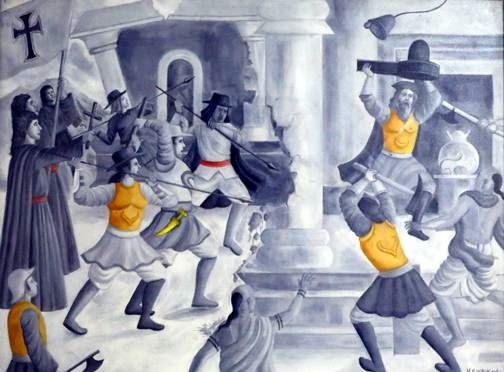
Countless of Hindus temples were broken by missionaries
In contemporary times, large parts of Northeastern India have become Christianized owing to the fervent activities of missionaries. In these states, especially Nagaland, Hindus are not able to celebrate Durga Puja and other essential festivals due to harassment and killing by Christian Terrorist groups. In Tripura, the “National Liberation Front of Tripura”, a designated terrorist organization, has targeted Swamis and temples for attacks. The Baptist Church of Tripura, instilled there by Christian white supremacists from New Zealand, has supplied NLFT with arms and financial support and encouraged the murder of Hindus, particularly infants. A conventional tactic of the terrorists is to torch houses of Hindus with the residents still in it.
They have been known to raid Hindu sanctuaries and shoot all the members. They have killed a total of 13,000 Hindus over the course of the 1990’s before they split up and most of them surrendered to the Indian Army. Similarly, the Baptist Christians in Manipur in India have also committed anti-Semitism on the Bnei Menashe Jews of India, denying the Jewish Rabbis from Shavei Israel to teach them the Talmudic laws (with which they were unfamiliar since the Bnei Menashe left Israel before the Talmud was written and concluded by Rabbi Hillel).
Similar atrocities were committed by Fundamentalist Christian terror groups such as the Nagaland Rebels, converted to Christianity in the same way as most others (i.e forcibly) and turned against Hindus.
Hindus in Fiji constitute approximately 38% of the population. During the late 90’s there were several riots against Hindus by radical elements in Fiji. In the Spring of 2000, the democratically elected Fijian government led by Prime Minister Mahendra Chaudhry was held hostage by a guerilla group, headed by George Speight. They were demanding a segregated state exclusively for the native Fijians, thereby legally abolishing any rights the Hindu inhabitants have now. The Hindu minority are denied any land owning rights and are routinely attacked and harassed. Several dozen Hindu temples have been vandalized or destroyed by arson or looting.
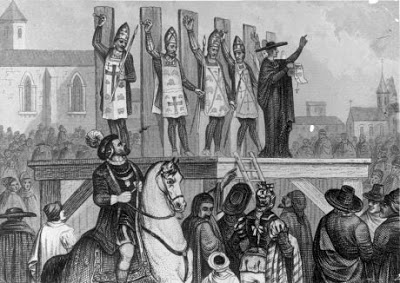
The Methodist church of Fiji repeatedly calls for the creation of a Christian State and has endorsed forceful conversion of Hindus after a coup d’etat in 1987.
Indians, predominantly Hindus, came as indentured laborers in 1838 to British Guyana and later to Trinidad, Jamaica, Grenada, St. Lucia, Martinique, Guadeloupe and Surinam. During the initial decades of Indian indenture, Indian cultural forms met with either contempt or indifference by the Christian majority. Hindus have made many contributions to Trinidad history and culture even though the state historically regarded Hindus as second-class citizens. Hindus in Trinidad struggled over the granting of adult franchise, the Hindu marriage bill, the divorce bill, cremation ordinance, and others. After Trinidad’s independence from colonial rule, Hindus were marginalized by the African-based People’s National Movement.
The opposing party, the People’s Democratic party, was portrayed as a “Hindu group”, and other anti-Hindu tactics were used against them. Hindus were castigated as a “recalcitrant and hostile minority”. Hindus were alienated by such Christian communal groups. The support of the PNM government to creole art forms in Carnivals, while their public rejection and ridicule of Hindu art forms, was a particular source of contention for the Hindu minority. The displacement of PNM from power in 1985 would improve the situation.
There has been persistent discontent among the Hindus with their marginalization. Many Christianized groups portray Hindus as “clannish, backward and miserly” (Just like Jews were characterized as such in Europe by Christians once). During the General Elections of 1986, the absence of the Bhagavad Gita and the Quran at polling stations for required oath-taking was interpreted as a gross insult to Hindus and Muslims. The absence of any Hindu religious texts at the official residence of the President of Trinidad and Tobago during the swearing in of the new Government in 1986 was perceived as another insult to the minority communities since they were represented in the government.
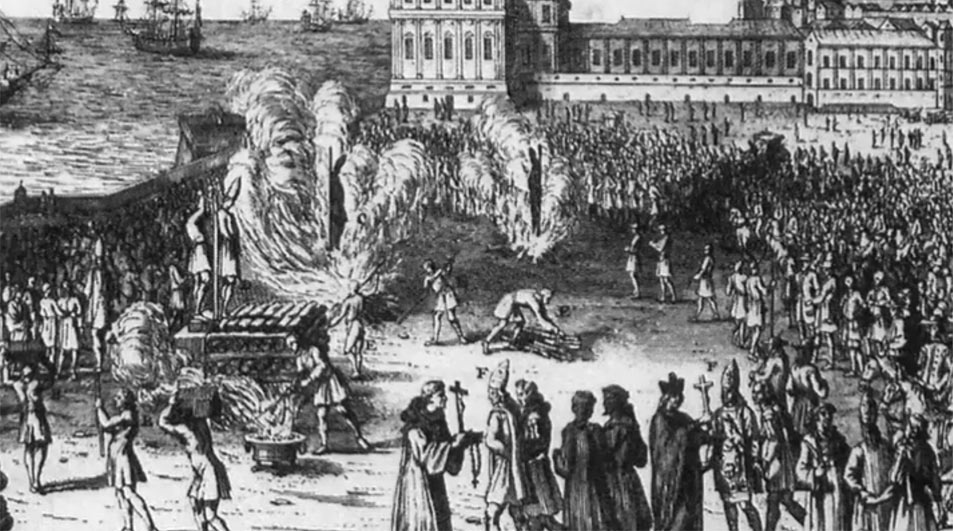
The exclusivist Christian symbolism operative in the country’s top national award, the Trinity Cross, has persistently stung Hindu religious sensibility. This was to climax in 1995 with the refusal of the Hindu Dharmaacharya to accept the award, while issuing a statement that his action should be seen as an opportunity for those in authority to create a national award that recognizes the plurality of religious beliefs in this country. The national education system and curriculum have been repeatedly accused of such majority-oriented symbolism.
The use of discernibly Christian-oriented prayers at Government schools, the non-representation of Hinduism in approved school textbooks, and the lack of emphasis on Hindu religious observace evoked deep resentment from the Hindu community. Intensified protests over the course of the 1980s led to an improvement in the state’s attitudes towards Hindus.The divergence of some of the fundamental aspects of local Hindu culture, the segregation of the Hindu community from Trinidad, and the disinclination to risk erasing the more fundamental aspects of what had been constructed as “Trinidad Hinduism” in which the identity of the group had been rooted, would often generate dissension when certain dimensions of Hindu culture came into contact with the State. While the incongruences continue to generate debate, and often conflict, it is now tempered with growing awareness and consideration on the part of the state to the Hindu minority. Hindus have been also been subjected to persistent proselytization by Christian missionaries.
Christian missionaries operate a network of hate sites and hate groups all over the world that spread misinformation and falsehoods against Hindus and incite others to attack and murder them.
Historian Alfredo de Mello aptly describes the performers of Goan inquisition as, nefarious, fiendish, lustful, corrupt religious orders which pounced on Goa for the purpose of destroying paganism (ie Hinduism) and introducing the true religion of Christ.
You may like
-


Seven Vows and Steps (pheras) of Hindu Wedding explained
-


Sari or Saree is symbol of Indian feminism and culture
-


Atithi Devo Bhava meaning in Hinduism and India
-


Navaratri: The Nine Divine Nights of Maa Durga!
-


Significance of Bilva Leaf – Why is it dear to Lord shiva?
-


Concept of Time and Creation (‘Brahma Srishti’) in Padma Purana
History
Snakes and Ladders, Originated in Ancient India called Mokshapat or Moksha Patamu
Published
4 years agoon
January 21, 2021By
Vedic Tribe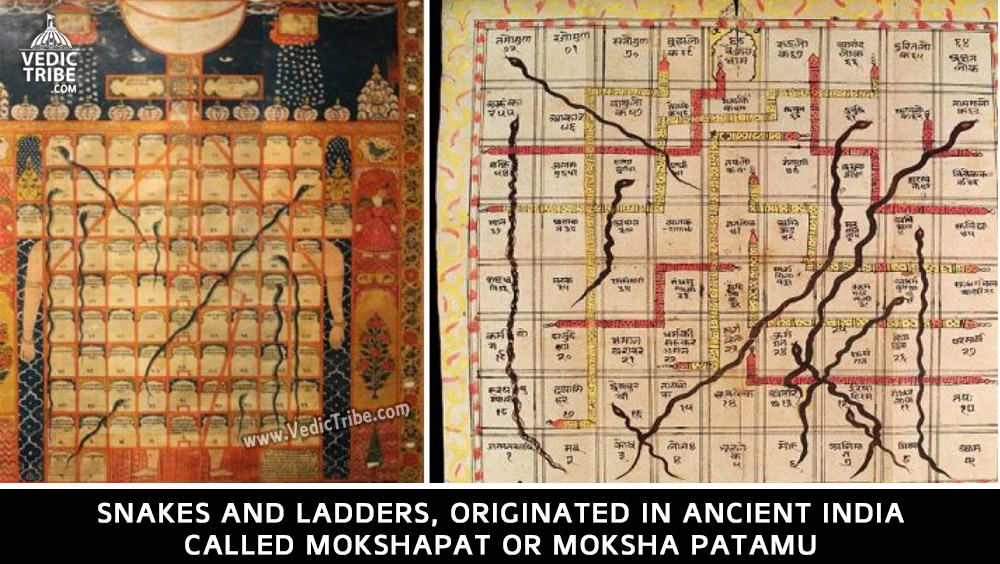
The board game, today called Snakes and Ladders, originated in ancient India, where it was known with the name Mokshapat or Moksha Patamu.
It’s not exactly known when or who invented it, though it’s believed the game was played at a time as early as 2nd century BC. According to some historians, the game was invented by Saint Gyandev.
Originally, the game was used as a part of moral instruction to children. The squares in which ladders start were each supposed to stand for a virtue, and those housing the head of a snake were supposed to stand for an evil. The snakes outnumbered the ladders in the original Hindu game. The game was transported to England by the colonial rulers in the latter part of the 19th century, with some modifications.
Through its several modifications over the decades, however, the meaning of the game has remained the same — ‘that good deeds will take people to heaven (Moksha) while evil deeds will lead to a cycle of rebirths in lower form of life (Patamu).
The modified game was named Snakes and Ladders and stripped of its moral and religious aspects and the number of ladders and snakes were equalized. In 1943, the game was introduced in the US under the name Chutes and Ladders.
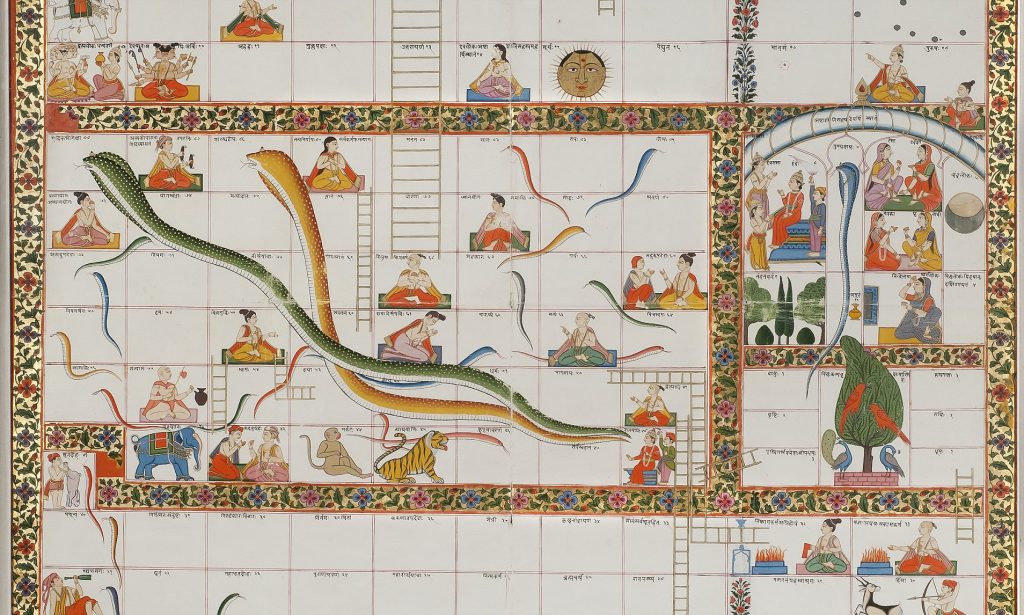
The Game of Knowledge
Originally, the game of Snakes and Ladders was known variously as Gyan Chaupar (meaning ‘Game of Knowledge), Mokshapat, and Moksha Patamu, and was originally a Hindu game. Nobody knows for sure as to who invented this game, or when it was created.
It may be said that whilst the gameplay of Gyan Chaupar is the same as today’s Snakes and Ladders, the board and higher objective of the game may be said to be quite different. Like the modern Snakes and Ladders board, the number of squares in that of Gyan Chaupar may vary. One version of this board, for instance, contains 72 squares, whilst another has 100. A major difference between the traditional and modern versions is the fact that in the former, a virtue or a vice and the effects of these virtues and vices, or something neutral is placed within each box.
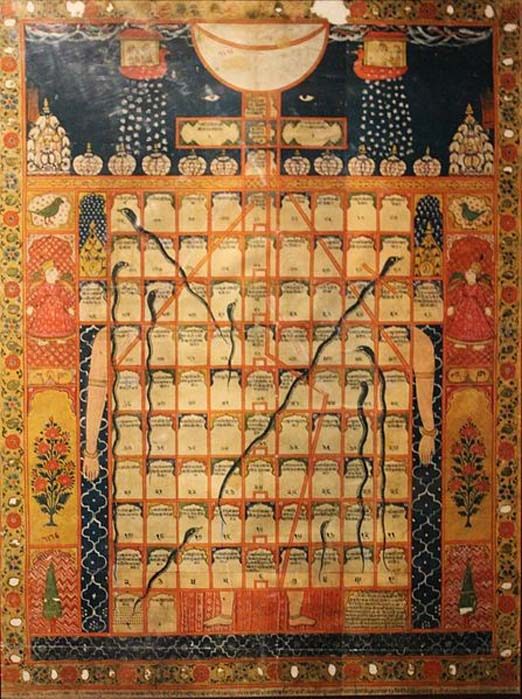
For instance, in an Indian Gyan Chaupar board of 72 boxes, squares number 24, 44, and 55 have the vices of bad company, false knowledge, and ego respectively. As the game places great emphasis on karma, the Hindu principle of cause and effect, each vice (the snakes’ heads) has a corresponding effect. Thus, for the vices mentioned above, the corresponding effects are conceit or vanity, plane of sensuality, and illusion. On the other hand, the virtues of purification, true faith, and conscience are contained in squares number 10, 28, and 46, and these lead to heavenly plane, plane of truth, and happiness respectively. In this version of the board, the goal is to reach box number 68, which is the plane of Shiva.
Religious Teaching Tool
This game was so popular that it was also adopted and adapted by other religions that existed in the Indian subcontinent. It is known that Jain, Buddhist, and Muslim adaptations of the game exist, as the concepts of cause and effect, and reward and punishment, are common to them. For devout followers of these religions, the game may be played as a form of meditation, as a communal exercise, and even as part of one’s religious studies without the use of more conventional books or sermons.
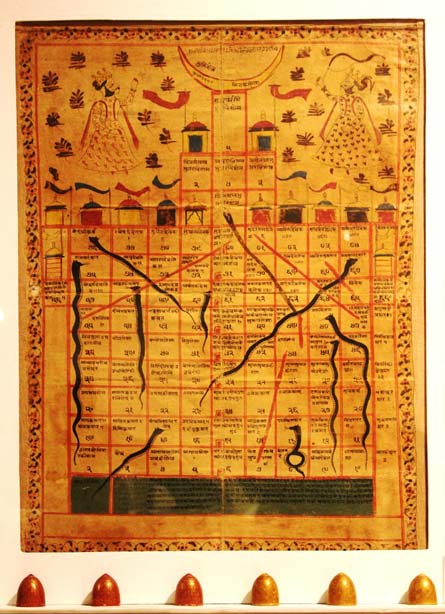
It may be added that many of the surviving game boards are works of art in their own right, as they contain elaborate illustrations of human figures, architecture, flora and fauna, etc. These boards were commonly made of painted cloth, and most of the extant ones date from after the middle of the18th century AD.
The Modern Game
The game of Gyan Chaupar became Snakes and Ladders towards the end of the 19 th century, when it was introduced to Great Britain by India’s colonial rulers. Whilst the original gameplay was maintained, its underlying philosophical message was greatly diminished. The religious virtues and vices were replaced by two-part cartoon dramas connected either by a snake or a ladder. Additionally, the number of snakes and ladders were equalized, whilst in the original ones, there were usually more snakes than ladders, which symbolizes the belief that it is far easier to fall prey to vice than to uphold virtue. From Great Britain, the game traveled to the United States, where it was introduced in 1943 by Milton Bradley as Chutes and Ladders.
Bharat
Telhara University – Older than Nalanda, Vikramshila Universities
Published
5 years agoon
December 29, 2020By
Vedic Tribe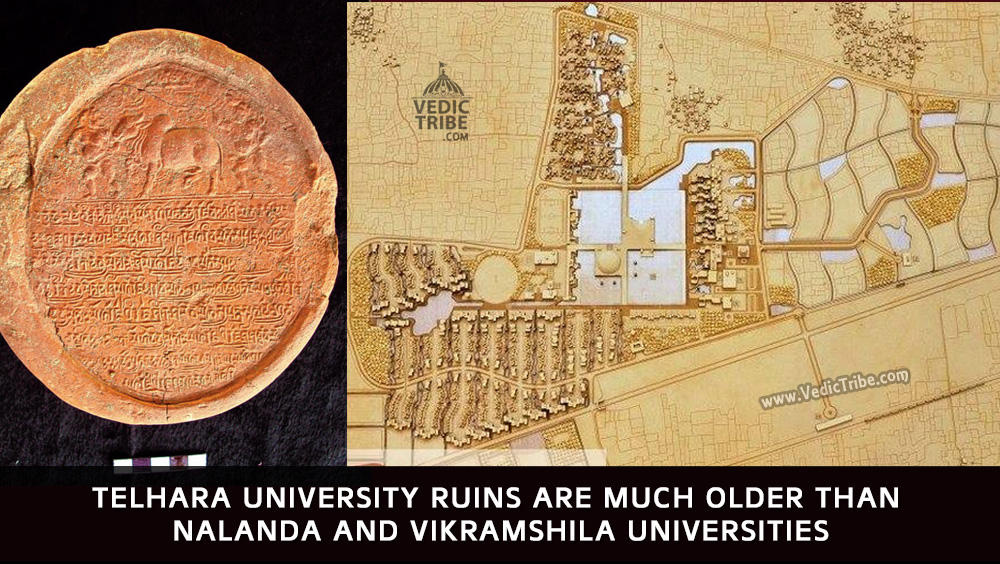
It was a useful mound, no doubt. A good vantage point where villagers occasionally relieved themselves.
But who would have thought that deep beneath its golden brown earth would be stories of dynasties and empires that now suggest that this — Telhara, a village 33 km from the ruins of the more famous Nalanda University — could be ‘Tilas-akiya’ or ‘Tiladhak’, the place Chinese traveler Hiuen Tsang visited and wrote about during his travels through India in 7th century AD? So far, there were only vague references but recent excavations at the mound suggest that Telhara was indeed an ancient university or seat of learning with seven monasteries.
The Bihar government has been calling the Telhara project one of its biggest after the excavations that unearthed Nalanda and Vikramshila universities. The excavation at Telhara should have happened earlier, say experts, but the site lost out to the more famous Nalanda.
The Telhara project that started on December 26, 2009, has so far come across over 1,000 priceless finds from 30-odd trenches — seals and sealing, red sandstone, black stone or blue basalt statues of Buddha and several Hindu deities, miniature bronze and terracotta stupas and statues and figurines that go back to the Gupta (320-550 AD) and Pala (750-1174 AD) empires. But the 2.6-acre mound has now thrown up the most tantalising find yet — evidence of a three-storied structure, prayer hall and a platform to seat over 1,000 monks or students of Mahayana Buddhism.
The terracotta monastery seals — a chakra flanked by two deers — unearthed at Telhara are similar to those at Nalanda, suggesting Telhara or Tiladhak was another great seat of learning besides Nalanda and Odantpuri during the Gupta and Pala reigns. It was the discovery of a similar monastery seal that clinched it for Nalanda University.
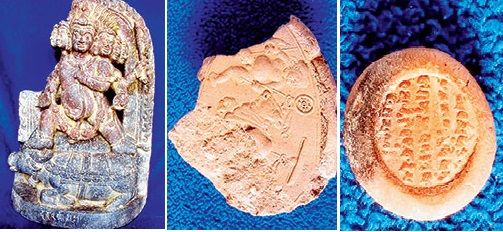
Former Archaeological Survey of India director B S Verma, who between 1971 and ’81 supervised the excavation at the site of the ancient Vikramshila university, says, “Telhara or Tiladhak has much more convincing epigraphical proofs — monastery inscriptions — than Vikramshila. The findings that match Hiuen Tsang’s account do more to convince that the place was a university or mahavihara similar to Nalanda.”
In his book, The Antiquarian Remains in Bihar, historian D R Patil writes about Hiuen Tsang’s description of Telhara. “Hiuen Tsang describes Telhara or Tilas-akiya as containing a number of monasteries or viharas, about seven in number, accommodating about 1,000 monks studying in Mahayan. These buildings, he says, had courtyards, three-storied pavilions, towers, gates and were crowned by cupolas with hanging bells. The doors and windows, pillars and beams have bas relieves (sculptures in guilded copper). In the middle vihara is a statue of Tara Bodhisatva and to the right (is) one of Avlokiteshwar”.
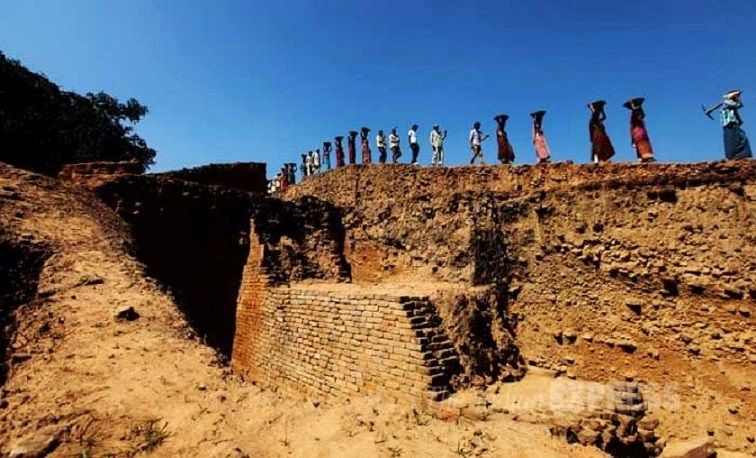
Other history books too talk of Tiladhak monastery, on the western side of Nalanda, as having four big halls and three staircases. It is said the mahavihara or university was built by one of the descendants of Magadha ruler Bimbisara. The monastery was decorated with copper and also had small copper bells that gently chimed in the breeze.
For months now, the excavation has been unearthing these stories. Apart from the mound that is now being dug up, Telhara has six other mounds — five of which have settlements and one which is partially elevated.
Atul Kumar Verma, director (archaeology) of the Bihar government’s Department of Art and Culture, says, “Since the excavations suggest that Telhara might have been a contemporary of Nalanda, it is quite possible that it was either an independent university for specialized education or that students graduating from Nalanda University would come here for specialized study. It is a great feeling to see the place emerging as the next big find after Nalanda. It has also aroused great curiosity and attracted even the likes of Nobel laureate Amartya Sen.” Sen wrote in the visitors’ book: “What a wonderful site, really thrilling! And so skillfully excavated and restored.”
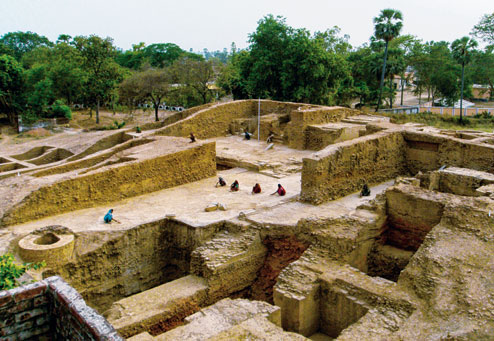
“We have found the courtyard that might have been an extension of the platform Hiuen Tsang had described,” Nand Gopal, camp in-charge at the Telhara site, says, peering into his optical line meter that’s mounted on a tripod.
In more recent times, it was A M Broadley, then magistrate of Nalanda, who in 1872 wrote about “Tilas-akiya” as a university and site of learning. British army officer and archaeologist Sir Alexander Cunningham, who visited the place between 1872 and 1878, wrote about inscriptions describing “Teliyadhak” as a place that had seven monasteries and which matched Hiuen Tsang’s account. A statue of the 12-armed Avlokiteshwar Buddha found from a Tiladhak site is at the Indian Museum in Kolkata. Perhaps the best known Pala sculpture from Telhara is now in Rietberg Muzeum, Zurich.
Though there was this and more proof that Telhara could be sitting on a glorious past, it wasn’t until December 2009 that the excavations finally began. Telhara panchayat head Awadhesh Gupta claims to have been the one who got things started.
“We all knew Telhara was once a great seat of learning, but nobody did anything to prove it. In 1995, I approached the Congress government requesting that the place be excavated but got no assurance. When Bihar Chief Minister Nitish Kumar visited the site in 2007, I put up this demand once again. The villagers were not happy with me. They thought I should have demanded something more concrete than just the digging of a mound.”
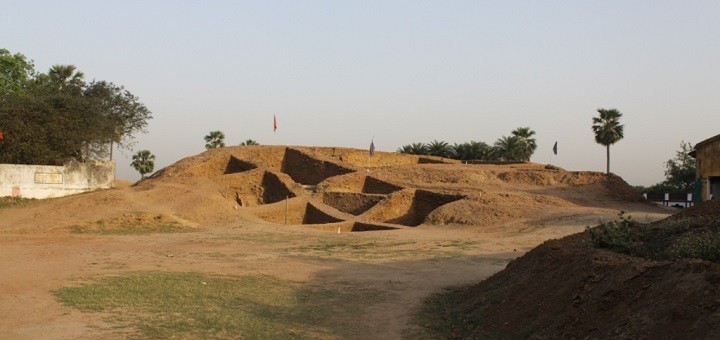
But the mukhiya may have had the last laugh. Villagers now talk about Telhara being part of the Nalanda-Rajgir circuit and how that could bring them jobs and better opportunities. “We hope the site is conserved and clubbed with Nalanda to attract tourists. The site has already given temporary jobs to 70 villagers,” says Anil Kumar, a villager.
It was a useful mound, no doubt.
Experts associated with its excavation are now claiming that the university originated in the Kushan period.
Atul Kumar Verma said that in the recent excavation, archaeologists have found some bricks of very large size (42x36x6.5cm) substantiating that the university belonged to the Kushan period. “Bricks of the Kushan period were quite large from other dynasties, including the Gupta and Pala periods,” said Verma.
While the Kushan period is considered to be 1st century AD, the Gupta dynasty ruled from 3rd to 6th century AD.
MAJOR FINDINGS
SEALS AND SEALING
The recovery of over 100 terracotta seals and sealings from the Gupta and Pala periods provides strong evidence of this being a Buddhist university. Besides seals of the chakra flanked by two deers, other seals have inscription of Buddhist mantras. Seals of Gaj-Lakshmi and flying birds were also found. Some inscriptions that have not yet been deciphered would be sent to Mysore for deciphering.
PLATFORM, TEMPLES
Just above the ashen layer — said to be proof of Turkish general Bakhtiyar Khilji having destroyed the monastery — is the sanctum sanctorum of three Buddhist shrines, each measuring 3.15 square metres. A big platform, found just below this ashen layer, is said to have accommodated over 1,000 monks.
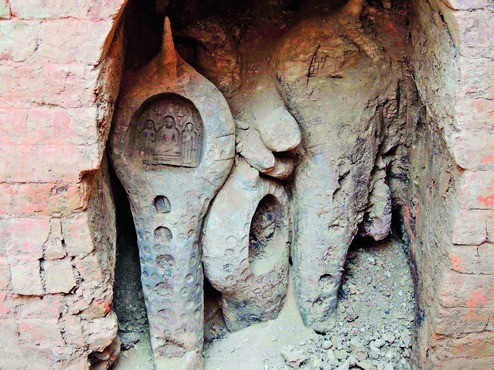
CELLS FOR TEACHERS
The excavation has so far revealed 11 cells of 4 square meters each. It is believed that these were faculty quarters. There is evidence of bricks from the Gupta and Pala periods.
COPPER BELL CHIMES
The excavation revealed several broken pieces of small bells. Parts of molten copper also suggest that the monastery was well-decorated.
CAUTION INSCRIPTION
A stone inscription in Sanskrit (early Nagari script), probably written just before the destruction of the Tiladhak mahavihara, says, “He who tries to destroy this monastery is either a donkey or a bull”. Below the stone inscription are images of the two animals.
FASTING BUDDHA AND VOTIVE STUPA
A miniature terracotta image of a fasting Buddha from the Pala period is a rare find. A six-foot-tall votive stupa from the Pala period suggests the prevalence of Buddhism.
MAURYAN PERIOD
Bone tools and pottery shards of Northern Black Polished Ware points to this being a settlement in the Mauryan period.
STONE SCULPTURES
Among the over 15 stone sculptures found at the site are a red sandstone sculpture of Bodhisatva, Avlokiteshwar, Manjusri and the Buddha in his ‘earth witness’ mudra. A black stone statue of Buddha in abhay mudra (fearless mode) from the Pala period has been found. The red sandstone Bodhisatva sculpture is believed to be from the Gupta period. Some sculptures of Hindu deities such as Uma Maheshwar and Ganesh and Vishnu from the later Pala period were also found. The presence of a Yamantaka sculpture is evidence of Tantric Buddhism at the monastery.
History
India’s first Islamic Mausoleum Was Built on Top of Ancient Hindu Temple
Published
5 years agoon
December 28, 2020By
Vedic Tribe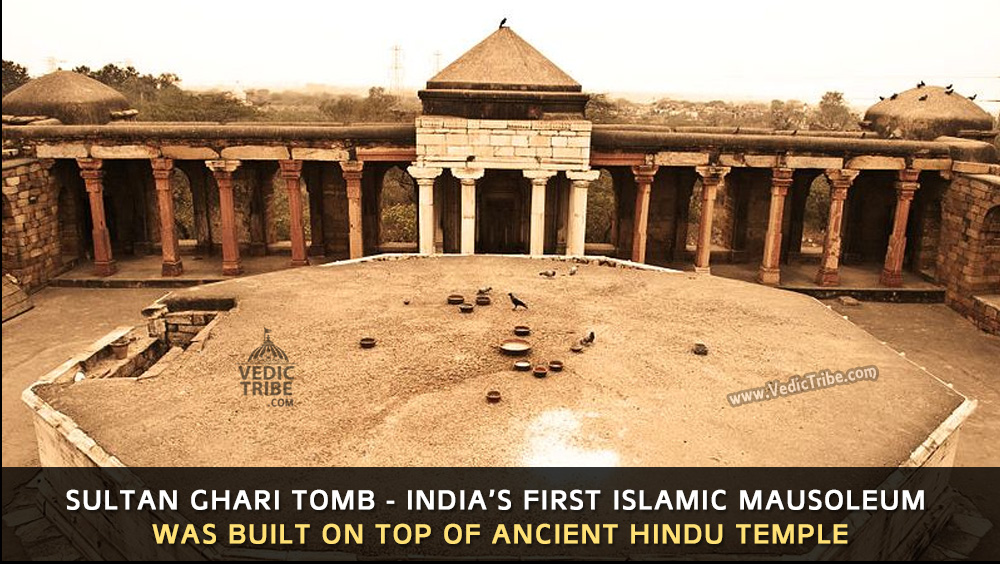
About 6 km west of Qutab Minar in Delhi, there lies a tomb called Sultan Ghari which is believed to be the final resting place of Prince Nasir’ud-Din Mahmud, the uncrowned eldest son of Sultan Shamsuddin Iltutmish of the Slave Dynasty built in 1231 AD. It was the first Islamic Mausoleum built in India.
However, engraved symbols of animals, Shiva Linga and the Sanskrit inscriptions on ceiling tell a different tale altogether. The beams of the octagonal crypt bear figures of Kamadhenu, the celestial cow and Varaha, the wild boar reincarnation of Lord Vishnu. These two animals were a royal Hindu insignia and considering the ideology of Islam against idols and the immense hatred towards pigs, it is very unlikely that such statues would adorn the inside of a Muslim tomb.
![]()
Iltutmish invaded eastern part of India in 1225 AD which resulted in signing of a treaty between him and Iwaz Khalji, the ruler of Eastern India. After a few successive battles, Prince Nasiru’d-Din Mahmud was appointed governor of Lakhnauti province who later merged the province of Oudh with Bengal and Bihar, gaining him the title of “Malik-us-Sharq” (King of the East) by his father.
The Prince was killed in 1229 AD after a very short rule of 18 months. Grieved by the death of his favourite son, Iltutmish commissioned the Sultan Ghari Tomb. After Iltutmish’s death in 1236, his daughter, Razia Sultana ruled the kingdom until her defeat and death in 1240 AD.
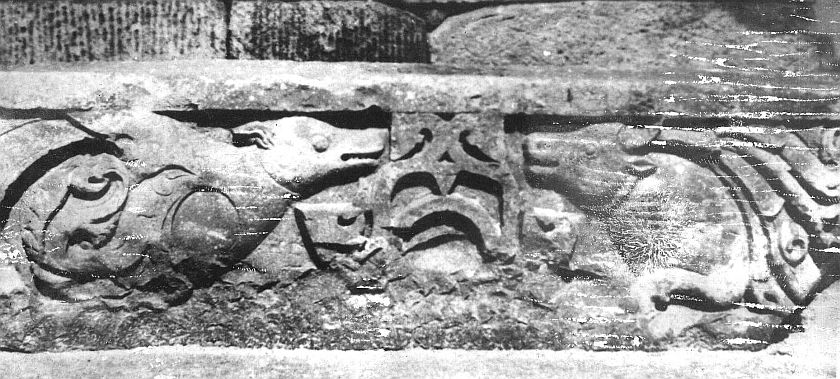
While ASI is pretty much silent on this matter, historians and archaeologists justify these carvings as new buildings being fashioned out of the debris of some Hindu buildings or that the workmen may have been Hindus and would have built the tomb in Hindu style. Their arguments in favor of the tomb fail here because no building worth its name can be build out of old debris and no workman would even dare to fashion a building for which he is hired according to his taste rather than that of the owner’s.
The building is also of an octagonal shape which is another Hindu specialty.
Due to indifference or perhaps purposeful negligence by the government and ASI, we may never know the reality and history of this ancient Hindu temple.

Follow us on Facebook
Follow us on Twitter
Latest


Seven Vows and Steps (pheras) of Hindu Wedding explained
Views: 7,633 Indian marriages are well renowned around the world for all the rituals and events forming part of the...


Sari or Saree is symbol of Indian feminism and culture
Views: 6,463 One of the most sensual attires of a woman in India is undoubtedly the sari. It is a...


Atithi Devo Bhava meaning in Hinduism and India
Views: 5,805 Atithi Devo Bhava, an ancient line taken from the Hindu scriptures and was originally coined to depict a visiting person whose...


Sanskrit Is More Than Just A Method To Communicate
Views: 4,702 -By Ojaswita Krishnaa Chaturvedi anskrit is the language of ancient India, the earliest compilation of sound, syllables and...


Significance of Baisakhi / Vaisakhi
Views: 5,852 Baiskhi is also spelled ‘Vaisakhi’, and is a vibrant Festival considered to be an extremely important festival in...


Navaratri: The Nine Divine Nights of Maa Durga!
Views: 6,879 – Shri Gyan Rajhans Navratri or the nine holy days are auspicious days of the lunar calendar according...


History of Vastu Shastra
Views: 9,498 Vastu Shastra (or short just Vastu) is the Indian science of space and architecture and how we may...


Significance of Bilva Leaf – Why is it dear to Lord shiva?
Views: 9,068 – Arun Gopinath Hindus believe that the knowledge of medicinal plants is older than history itself, that it...


Concept of Time and Creation (‘Brahma Srishti’) in Padma Purana
Views: 9,480 Pulastya Maha Muni affirmed to Bhishma that Brahma was Narayana Himself and that in reality he was Eternal....


Karma Yoga – Yog Through Selfless Actions
Views: 8,745 Karma Yoga is Meditation in Action: “Karma” means action and “yoga” means loving unity of our mind with...

